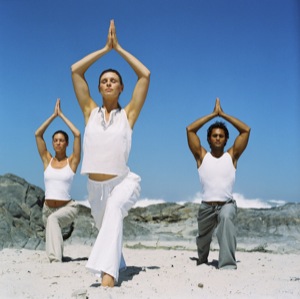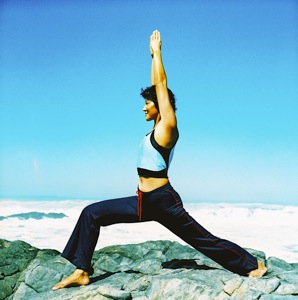-
- Maryland’s highest court upholds same-sex marriage ban
- Measure to end workplace bias against gays gains traction
- Judge rejects state bid to stop hormone therapy for transgender
- Jerry Falwell’s son urges ministers to ‘change the culture’
- Gay governor’s wife wants fourfold increase in support
- Old Times Square theater doomed by ‘progress’
- National News Briefs
- World News Briefs
health & sports
Fit for Life
Down dog, warrior pose and more: a yoga primer
Published Thursday, 20-Sep-2007 in issue 1030
Down dog. Child’s pose. Cow face. Scorpion pose. Sound like phrases heard in an episode of Barney? Not so. These are four of the many postures practiced by yogis all over the world. These names may sound somewhat silly for a serious practice that’s rooted in religion (these terms are actually derived from Sanskrit, a classical Indian language), but performing the activities they describe is anything but.
Yoga originated in India some 5,000 years ago and was created to help gain greater interconnectedness between mind, body and spirit through exercise, breathing techniques and meditation.
Originally a practice associated with Hinduism, yoga has become a mainstream form of exercise and meditation. According to a 2005 “Yoga in America” survey conducted by Yoga Journal, approximately 16.5 million U.S. citizens participated in some form of yoga the previous year. That’s nearly as many people residing in the entire state of New York. IDEA Health and Fitness Association, the leading provider of continuing education for fitness professionals, cites yoga as the 14th most popular program offered in fitness facilities today. Its popularity isn’t surprising considering the many potential benefits practitioners can gain, aside from greater flexibility, stamina and centeredness.
Countless research studies have examined the more intrinsic benefits of regular practice and have found that yoga can help reduce the propensity for such maladies as depression, heart disease, obsessive-compulsive disorder; can help alleviate stress and relieve symptoms associated with it. Some of the most prolific back surgeons now hesitate to send patients under the knife, and instead urge them to give yoga a try before heading to the operating room. These experts have found that yogic intervention has often proved more triumphant in treating back pain than surgery, which has a very low success rate.
Since its origin, yoga has taken on many different forms, from those that emphasize spiritual awakening and meditation to more movement-oriented styles such as Punk Rock Yoga (yes, you read that right) and power yoga. We’ll examine the most popular forms available today, and why you may want to implement one or more of them into your weekly routine.
Ashtanga
This “eight-limbed yoga” is a practice that is aimed at internal purification as well as great control of the senses and self-realization. Each practitioner seeks to focus on both external and internal cleansing through moral codes, self-purification and study, posture (asanas), breath control (pranayama), sense control, concentration, meditation and contemplation. Experts explain that the combination and sequence of pose and breath initiates significant internal heat which helps purify the muscles and organs, rids the body of toxins, releases necessary hormones and minerals and improves blood circulation.
Bikram
Bikram Choudhury, founder of the Yoga College of India, is responsible for the inception of Bikram, or “hot,” yoga, which requires a room temperature of about 90-100 degrees. Choudhury explains that the combination of 26 poses, breath work and heat help improve muscle, ligament and tendon pliability, which can reduce the potential for injury. The heat also serves as a method for increasing the rate at which toxins are expelled through sweat, while the poses strengthen muscles and help improve internal organ function. If you thrive in warm temperatures, love to sweat and appreciate routine, this type of yoga may be your best bet.
Vinyasa Flow
Vinyasa (Sanskrit term for breath-synchronized movement) Flow yoga is derived from Ashtanga and requires that the student move from pose on an inhale or exhale. Each pose transitions from one to the next in a fluid pattern and tends to be more movement oriented than other methods.
Unlike Bikram or Vinyasa, instructors are not limited to strict guidelines for the sequence of poses, which means that each class can be different from the next. Cynthia Roth, Marketing Strategist for IDEA Health & Fitness Association said Vinyasa is her preferred method for that reason. “It is the asanas of Ashtanga, but mixed up so it’s not always the same class,” she says. “It gives me time to get in my head, connect to the areas of my body that need to be released and provides an all-over active stretch that I am too lazy to do every week.”
Kundalini
With an emphasis on connecting the participant to his psychic powers, or chakras, Kundalini yoga incorporates various postures, verbal utterances, meditations and more. This type of yoga can be physically demanding, however practitioners benefit from the more internal benefits it offers, such as improved awareness of self, mental clarity and intuition.
This format is not for everyone, but can be tremendously beneficial for those looking to achieve greater physical, spiritual and mental balance.
Misc
The popularity of yoga has led to the creation of many alternative styles. One such alternative is PiYo which was developed by fitness celebrity and Southern California native Chalene Johnson. On her Web site, www.turbokick.com, she describes PiYo as a mind-body practice for “hyper people.” It is a combination of Pilates, yoga and dance and offers participants a method for improving fitness levels via continuous and challenging movements.
For those of you who don’t believe in fitness without external resistance, a variety of yoga-with-weights programs such as Iron Yoga have been developed to satisfy your inner strength trainer.
If you’re comfortable enough to perform a down dog or cow stretch sans the restrictions of clothing, nude yoga may be the option for you. These “non-sexual” classes are often men-only (though female and mixed classes are available) and tend to appeal to the gay community, although most organizations offering it welcome straight males as well. Participants remove their clothing to “free themselves of judgment and body consciousness” which is meant to allow them to get right to the root of the practice. These are just a few examples of available yoga-oriented classes. Google “yoga fusion” and you’ll come up with hordes of unique and interesting formats.
Whatever your interest – whether spiritual, mental or physical – there is a yoga class to suit everyone’s needs. From renewed flexibility to improved physical strength, yoga can significantly enhance your current workout, or it can be a method to get the body primed for starting out. If you’re interested in beginning a practice, but have been somewhat hesitant to do so, Roth suggests moving past that fear and heading to a local studio for the first time. “Go to an intro class at a studio (not a gym), get there early, tell the instructor you are new and nervous and remember it is their passion and paying job to make it an enjoyable experience for you.” This way the instructor will be able to keep his eye on you and guide you through the class in a safe and effective manner.
|
|
Copyright © 2003-2025 Uptown Publications




